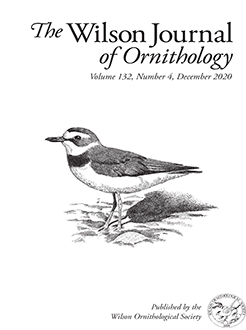The Northern Saw-whet Owl (Aegolius acadicus) is a highly migratory owl that occurs throughout North America. Banding stations have studied the migratory habits of this species, but these studies rarely collect significant data regarding the origin of migrant birds captured in the midwestern United States. In the last 20 years Northern Saw-whet Owl ecology has been studied broadly; however, little is known how different populations may interact with one another. Many avian species with large geographic ranges often have populations that breed and winter in separate areas. Little has been documented to establish if this pattern exists in Northern Saw-whet Owls, a species where individuals are migratory, sedentary, and nomadic. Stable isotope ratios using deuterium δ2H in feathers have been successfully used to estimate the breeding origin of birds. We used stable isotope analysis of δ2H in conjunction with an isoscape map to determine breeding origins for Indiana Northern Saw-whet Owls. We collected 41 feather samples from migrating owls at 6 different banding sites across Indiana from October to November 2017. Because higher enrichment values in adult owl feathers complicate analysis, we only analyzed samples from young (hatching-year) individuals. After analysis and exclusion of birds identified as outliers, the model suggested that the birds originated along 44°N around the Great Lakes Region and as far east as Nova Scotia, Canada. When including outliers, the model suggested that individuals originated along 40°N between Iowa and New York. The outliers-excluded model remained more consistent with the known breeding range of this species than the outliers-included model. We successfully used this technique and our data suggests that the majority of Northern Saw-whet Owls originated from the Great Lakes Region. We recommend further investigation on the physiology and behavior of owls on the breeding grounds, which could aid in the ability to better understand differences in δ2H enrichment of this species. Better understanding of this would allow these models to be plotted more precisely onto the landscape.
How to translate text using browser tools
14 September 2021
Delineating the origin of migratory Northern Saw-whet Owls (Aegolius acadicus) in Indiana using stable isotope analysis
Landon K. Neumann,
Ashley E. Higdon,
Elizabeth A. Flaherty,
Brad J. Bumgardner,
Amy B. Wilms,
Kaitlin D. Gavenda,
Clayton D. Delancey,
John B. Dunning Jr.
ACCESS THE FULL ARTICLE
bird banding
deuterium
Indiana
isoscape map
migration
raptors





